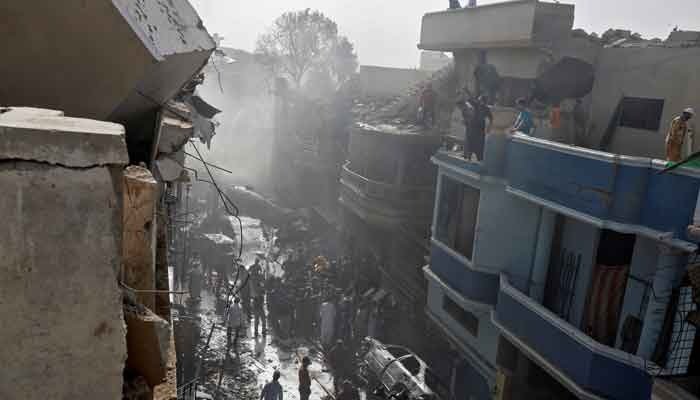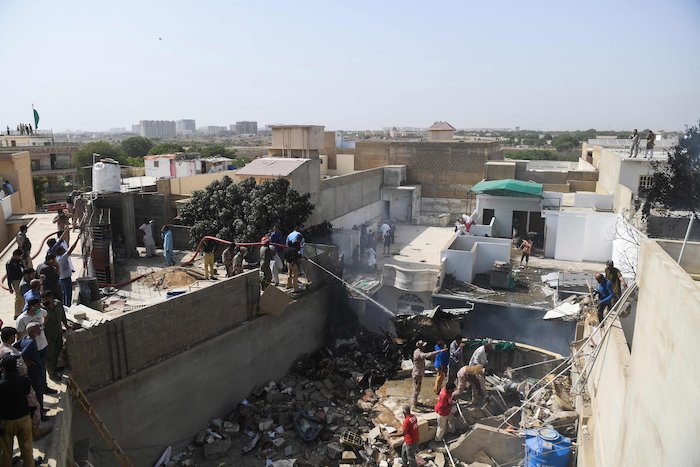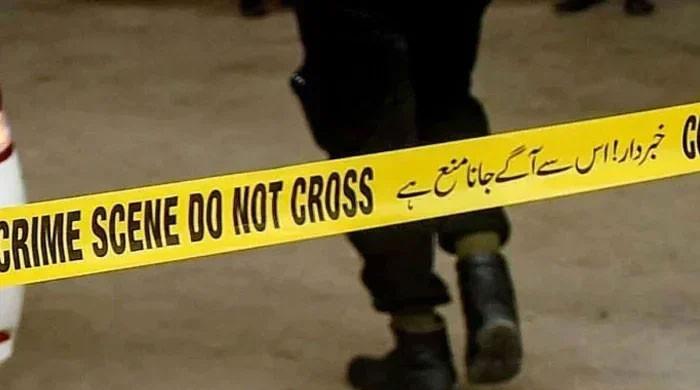PK-8303 tragedy: Pakistan marks one year since deadly PIA plane crash in Karachi
On May 22, 2020, a PIA plane coming from Lahore crashed in Karachi, killing 97 people
May 22, 2021
One year has passed since the tragic crash of PIA flight PK-8303 in Karachi, which killed 97 people on board while two passengers had survived miraculously.
On May 22, 2020, the PIA plane crashed into a residential area near Model Colony in Karachi's Malir neighbourhood after losing its engines. The PK-8303 tragedy has become the third most-catastrophic aviation disaster in the country's history.
An investigation into the plane crash, however, still remains inconclusive.

According to a preliminary investigation report prepared by the Aircraft Accident Investigation Board, which works under the Ministry of Aviation, the pilots were not focused and their lack of concentration caused the crash.
During the ill-fated flight, the pilots made a first landing attempt and the plane briefly touched the ground multiple times, before attempting to land for a second time.
The report had stated that the cause of the crash was not a malfunction in the plane, but due to the negligence of the pilots and air traffic controllers.
A month after the crash, Federal Minister for Aviation Ghulam Sarwar Khan had presented the interim investigation report on the PIA plane crash in the National Assembly.
Sarwar said that the conversation between the pilot and the air traffic controllers had been recorded and he had heard it himself.
Sarwar said that the initial report pointed out that there was no technical fault with the aircraft and even the pilot had said the same in his conversation with the air traffic controllers.
'No technical fault with aircraft'

Speaking about the aircraft, Sarwar said that no technical fault could be found in it. “Because of the coronavirus, flights had been suspended. The plane took the first flight after operations resumed on May 7 and between then and May 33, the plane completed six flights,” he had said.
“Five flights were from Lahore to Karachi and Karachi to Lahore, while one flight was to Sharjah,” the minister told the Parliament. He added that both the captain and his co-pilot were medically fit to fly as well.
'Pilots ignored instructions from ATC'
The minister disclosed that the aircraft touched the runway thrice without the landing gear which caused damage to its engines. "When the plane took off again, both its engines had been damaged," he said.
He added that the initial report mentioned that the plane’s data entry record showed that as the plane was 10 nautical miles from the runway, its landing gears had opened.
“But the one thing that cannot be explained is that when the plane was at five nautical miles away, the landing gears were pulled up. This action is also there in the data recorder,” said the minister. He added that whenever a plane comes close to landing, it has to be provided a flexible position.
Read more: Preliminary report holds pilots, ATC responsible for PIA plane crash
The minister told the House that while assessing the two most “important evidence” from the flight data recorder of the DFDR, in which all actions of the plane are recorded, and the cockpit voice recorder, the “first irregularity” was noticed when the pilot approached the runway.
“The plane was supposed to be at the height of 2,500 feet at 10 nautical miles before coming near the runway. According to the initial report and the record, the plane was at a height of 7,220 feet. This is was the first irregularity,” said the minister.
He added that the air traffic controller (ATC) reminded the pilot thrice that his aircraft's height was much higher than the recommended limit and advised him not to take the landing position and instead, take another round of the airport.
"The pilots and the air traffic controllers both did not follow the protocol," he said. "The pilot ignored the instructions of the air traffic controllers and the ATC, on the other hand, did not inform the pilot about the engines' collision."
The minister said that when the pilot was informed about the dangerous height at which the aircraft was, he did not pay heed to it and said that it would be 'managed'.
“The fault was at both ends. The ATC was at fault as well when it saw the plane doing the touchdown on the engines and saw a fire erupting, it should have informed [the pilot] but the control tower did not. And when the pilot took off, both the engines were damaged by that time,” the minister said.
Sarwar said that the pilot and the co-pilot were not focused and their lack of concentration had resulted in the plane crash. The minister added that the pilots were discussing the coronavirus as it had affected their families and were not paying attention to their job.
PK-8303 tragedy: PIA announces increase in compensation for plane crash victims
The minister said that it was observed that the pilot took the call “very hurriedly” and told the tower that he would “manage”. He added that recorder showed that even after taking the call the pilots went back to their conversations about coronavirus.
“The pilot then again requested another approach but unfortunately the approach he was given and the height he was given, it [aircraft] could not reach there and crashed on the civilian population,” said the minister while explaining what the report said about the final minutes of the plane.
The federal minister further said that the cabin crew and ATC were also responsible for the tragedy. "Those who have passed away, may God forgive them. Those who are alive and are responsible will be held accountable," he added, promising that the complete investigation report will be presented in a year's time.
You can read the full investigation report from last year below.











